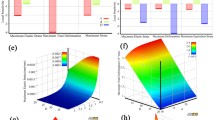Abstract
The multi-axis force–torque sensor is a key element of many accurate force and motion control systems, including intelligent robotic systems. This paper presents a novel elastic structure for multi-axis force–torque sensors that is easily manufacturable at low cost and has many detection points with high surface strains. By using the “design of experiment” method in the ANSYS software, we demonstrate that the designed elastic structure with four identical T-shapes has high surface strains and can provide various strain gauge configurations. The strain sensitivities of the elastic structure at predetermined points can be maximized manually by varying the thickness of the vertical and horizontal beams of the T-shaped components. The validity of the proposed elastic structure is demonstrated through the development of a low-cost six-axis force–torque sensor. Experimental results for the developed force–torque sensor with the proposed elastic structure demonstrate that the proposed structure is comparable to an expensive state-of-the-art commercial force–torque sensor.
Similar content being viewed by others
References
Z. Liandong and Z. Changjiu, Human and humanoid robot interaction using 6-axis force torque sensors, Proc. of 7th IEEE Conference on Industrial Electronics and Applications (ICIEA) (2012) 1274–1278.
P. Li, D. Wu, S. Xu and Y. Cui, A novel methodology of calculating the human-machine interactive force for a head-neck exoskeleton, Journal of Mechanical Science and Technology, 32 (2018) 4383–4397.
C.-G. Kang, Robo Armwrestler, IEEE Control Systems Magazine, 28 (5) (2008) 24–31.
C.-G. Kang, A novel arm-wrestling robot using motiondependent force control, Service Robot Applications, Chapter 16, I-Tech, Austria (2008) 271–282.
K. Park et al., Effect of elastomer characteristics on fiber optic force sensing performance in biomedical robotics applications, Journal of Mechanical Science and Technology, 32 (12) (2018) 5631–5636.
R. A. Brookhuis, T. S. J. Lammerink, R. J. Wiegerink, M. J. de Boer and M. C. Elwenspoek, 3D force sensor for biomechanical applications, Sensors and Actuators A: Physical, 182 (2012) 28–33.
C. Yuan et al., Development and evaluation of a compact 6- axis force/moment sensor with a serial structure for the humanoid robot foot, Measurement, 70 (2015) 110–122.
C.-G. Kang, Closed-form force sensing of a 6-axis force transducer based on the Stewart platform, Sensors and Actuators A: Physical, 90 (2001) 31–37.
C.-G. Kang, Maximum structural error propagation of multi-axis force sensors, JSME International J. Series C-Mechanical Systems, Machine Elements and Manufacturing, 44 (3) (2001) 676–681.
C.-G. Kang and J.-H. Han, Force analysis of a Stewart platform- based force/torque sensor using a linearization technique, Proc. of the Dynamic Systems and Control, ASME International Mechanical Engineering Congress and Exposition, Atlanta Hilton and Towers, Atlanta, USA, DSC-vol. 58 (1996) 747–752.
C.-G. Kang, Analysis on force sensing errors of force-torque sensors, Trans. Korean Society of Mechanical Engineers A, 22 (7) (1998) 1250–1257 (In Korean).
C.-G. Kang, Force-sensing error propagation in multi-axis force sensors, Trans. Korean Society of Mechanical Engineers A, 24 (11) (2000) 2688–2695 (In Korean).
C.-G. Kang, Performance improvement of a 6-Axis forcetorque sensor via novel electronics and cross-shaped doublehole structure, International J. of Control, Automation and Systems, 3 (3) (2005) 469–476.
M.-T. Ha, S.-H. Jeon and C.-G. Kang, The effect of geometry parameters on sensitivity of multi-axis force-torque sensor, Proc. of the 11th Korea Robotics Society Annual Conference, Phenix Park, Korea (2016) 78–81.
J.-Y. Kim and C.-G. Kang, Strain analysis of a six-axis forcetorque sensor using cross-shaped elastic structure with circular holes, J. of the Korean Society of Precision Engineering, 16 (2) (1999) 5–14 (In Korean).
J.-H. Yi and C.-G. Kang, Signal processing and performance of a six-axis force-torque sensor using strain gages, J. of Control, Automation and Systems Engineering, 7 (2) (2001) 146–151 (In Korean).
J.-W. Kim, H.-S. Hong and C.-G. Kang, Experimental analysis on a 4 leg-type force-torque sensor, Proc. of 2011 8th Intern. Conf. on Ubiquitous Robots and Ambient Intelligence, Songdo Convention, Incheon, Korea (2011) 421–424.
Acknowledgements
This research was supported by Basic Science Research Program through the National Research Foundation of Korea (NRF) funded by the Ministry of Education (Grant No. 2017R1D1A1B04029966).
Author information
Authors and Affiliations
Corresponding author
Additional information
Recommended by Editor No-cheol Park
Manh-Tuan Ha received his B.S. and M.S. degrees in Mechanical Engineering from the Hanoi University of Science and Technology, Vietnam in 2005 and 2008, respectively. He received his Ph.D. in Mechanical Engineering from Konkuk University, Seoul, Korea in 2019. He is currently a lecturer in School of Transportation Engineering at Hanoi University of Science and Technology. His research interests include intelligent control, robotics, and railway braking.
Chul-Goo Kang is a Professor of Mechanical Engineering at Konkuk University, Seoul, Korea. He received his B.S. and M.S. degrees in Mechanical Design and Production Engineering from Seoul National University in 1981 and 1985, respectively. In 1989, he received his Ph.D. in Mechanical Engineering from the University of California, Berkeley, USA. Since 1990, he has been a Professor of Mechanical Engineering at Konkuk University and is currently the Director of the Intelligent Control and Robotics Lab, and the Railway Vehicle Lab. He served as the Organizing Chair of the International Conference on Control, Automation, and Systems in 2012 and as the President of the Korea Robotics Society in 2015. He is currently a member of the National Academy of Engineering of Korea. His research interests include motion control, force sensing and control, robot manipulation, and railway vehicles.
Rights and permissions
About this article
Cite this article
Ha, MT., Kang, CG. Elastic structure for a multi-axis forcetorque sensor. J Mech Sci Technol 34, 23–31 (2020). https://doi.org/10.1007/s12206-019-1203-3
Received:
Revised:
Accepted:
Published:
Issue Date:
DOI: https://doi.org/10.1007/s12206-019-1203-3




